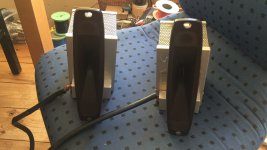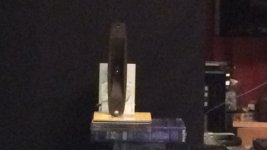Mine is taking the opposite route from Lampie519 regarding grounding. All grounds only meet at the galvanic isolated I2S source and then to balanced floating preamp and monoblock power amps. Currently I'm rebuilding it in a way that it will be able to play both NOS and OS from the same chips working at the same operating conditions. The plan is to install a front panel switch to select mode "on the fly". Then there will be a lengthy as necessary listening comparison before I move further to this adventure: NOS, Oversampling... and now Hybrid(?)
Hi MagicBus,
as much as I appreciate your experiments, you just cannot use my name and brand "DDDAC" on something I did not design or produce. You are infringing my copyrights by doing so.
So please remove it from your PCB, make a statement in the DIY forum and stop doing this in the future. especially do not make this commercial by offering PCBs or something (DIY use is fine, but still you should not use the "DDDAC" printed in any documentation or on your PCBs)
I know that mostly there is no ill intention behind this, but we have rules to stick to, right?
thanks
doede
Hi Doede,
My intentions were quite on the opposite side of violating copyright... I thought that since my built started from original DDDAC and later based on your schematics anyway, I should give credits rather than just putting my name on it. I believe it is self explanatory that this is a DIY version, definitely not something to sell or give away... For people who will ask, I feel obliged to refer to source schematics but I can remove any reference from my pcb if this works to keep peace in this forum!
Best regards
Kostas
My intentions were quite on the opposite side of violating copyright... I thought that since my built started from original DDDAC and later based on your schematics anyway, I should give credits rather than just putting my name on it. I believe it is self explanatory that this is a DIY version, definitely not something to sell or give away... For people who will ask, I feel obliged to refer to source schematics but I can remove any reference from my pcb if this works to keep peace in this forum!
Best regards
Kostas
Delta-Sigma any good in NOS mode?
Not exactly an answer to your question, but when you are referring to quasi-NOS, I run a Soekris R2R sign magnitude dam1121 in quasi-NOS and yes, it's good. By quasi-NOS I mean it always upsamples to 2.8/3.1 MHz but the FIR stage is ZOH. Other posts on these forums have shown it to have perfect impulse response, no ringing and flat phase.
If you haven't heard of the Soekris dam's, they run off a programmable FPGA chip that you can design and load four different filter types in. So it's relatively easy to do A/B testing in. Limitation is that the IIR stage has to be the same for all FIR filters.
From the manual:
The dam1121 upsamples everything to the final 2.8/3.1 Mhz DAC sample rate in two steps, there are three different filters in the dam1121:
FIR1, when input is PCM it will upsample from incoming sample rate to 352/384 Khz in one step, with different filter lenght based on incoming sample rate, when input is DSD it will be filtered and decimated to 352 Khz . There can be four different set of filter types.
IIR, bank of 15 biquads operating at 352/384 Khz, with one used for the CD de-emphasis filter, none otherwise used for the basic DAC.
FIR2, upsampling from 352/384 Khz to 2.8/3.1 Mhz. There can be four different types, usually matching those in FIR1
Next to ZOH I have also tried quasi-NOS filters with a low number of taps (128 taps, 16 samples keeping zeroes) and that also produces "NOS sound".
Dipping my toes here, I don't have any fancy measuring equipment but let me know if there's anything I can do to help.
Hi Doede,
My intentions were quite on the opposite side of violating copyright... I thought that since my built started from original DDDAC and later based on your schematics anyway, I should give credits rather than just putting my name on it. I believe it is self explanatory that this is a DIY version, definitely not something to sell or give away... For people who will ask, I feel obliged to refer to source schematics but I can remove any reference from my pcb if this works to keep peace in this forum!
Best regards
Kostas
Thanks Kostas, it is important for me, that everyone understands this. As said I have no doubt you all meant well. For me case closed
I use the Chord M Scaler filter (build in the Chord Blu transport)
Not the M Scaler then. Can't leave off the "MKII"
Last edited:
Same filter... The stand alone Hugo M Scaler is on my wish list...
From what I have read the Blu MK2 has the same number of taps as the M Scaler. I'd wait for the next giant leap in taps.
Mine has the same filter not the same amount of taps (so yes it is not equal), and as i do not need more then 2x 176.4kHz the Hugo M scaler should be just fine.From what I have read the Blu MK2 has the same number of taps as the M Scaler. I'd wait for the next giant leap in taps.
From the Chord website:
Blu is capable of bit-perfect data extraction from CD and features selectable up-sampling from 44.1 to 176.4kHz to maximise accuracy before the signal is passed to a partnering DAC.
Built in up-sampler to 88.2 or 176.4kHz with 4096 Tap Length WTA Filter
Marcel's Valve Dac is very interesting indeed !
I have had the pleasuse of listening to it ...
I am not sure if it is the valves that are "magic" here or his general approach of this matter.
As far as i know there is a SS version as well but have not yet heard that one in comparison.
I have had the pleasuse of listening to it ...
I am not sure if it is the valves that are "magic" here or his general approach of this matter.
As far as i know there is a SS version as well but have not yet heard that one in comparison.
MagicBus' Disconnected Tweeter Experiment
For anyone conducting the disconnected tweeters experiment suggested by MagicBus, I would expect that you will obtain one of the following five results:
1) There is no difference in character between the two, but both modes now sound like OS.
2) There is no difference in character between the two, but both modes now sound like NOS.
3) The classic character difference between OS and NOS remains apparent, just without much treble.
4) There is a difference in character between the modes, but now NOS mode sounds like the best of OS and NOS combined.
5) There is a difference in character, but neither mode sounds like OS or like NOS. Which could easily be a deceptive subjective result, as the treble has been removed from playback, leaving the system tonally imbalanced.
Of those five results, the one I would most expect is #3. The most intriguing would be #4. Which is probably the most unlikely. Result #3 or #4 point directly to the next logical area of suspicion. Which is, the means whereby image-band suppression is being implemented, especially with regards to digital interpolation-filters.
For anyone conducting the disconnected tweeters experiment suggested by MagicBus, I would expect that you will obtain one of the following five results:
1) There is no difference in character between the two, but both modes now sound like OS.
2) There is no difference in character between the two, but both modes now sound like NOS.
3) The classic character difference between OS and NOS remains apparent, just without much treble.
4) There is a difference in character between the modes, but now NOS mode sounds like the best of OS and NOS combined.
5) There is a difference in character, but neither mode sounds like OS or like NOS. Which could easily be a deceptive subjective result, as the treble has been removed from playback, leaving the system tonally imbalanced.
Of those five results, the one I would most expect is #3. The most intriguing would be #4. Which is probably the most unlikely. Result #3 or #4 point directly to the next logical area of suspicion. Which is, the means whereby image-band suppression is being implemented, especially with regards to digital interpolation-filters.
Last edited:
More Frans Sessink
While we wait a bit to give those who may be conducting MagicBus' disconnected tweeter experiment more time to report their results, and for anyone to offer a counter-argument regarding whether the human ear, plus loudspeaker tweeter roll-off, effectively band-limits ALL digital playback, including NOS, I've attached two more interesting documents by Frans Sessink.
One is a practical guide to implementing a post DAC S/H circuit. The other contains what Frans sees as general problems with digital audio technology. Enjoy.
While we wait a bit to give those who may be conducting MagicBus' disconnected tweeter experiment more time to report their results, and for anyone to offer a counter-argument regarding whether the human ear, plus loudspeaker tweeter roll-off, effectively band-limits ALL digital playback, including NOS, I've attached two more interesting documents by Frans Sessink.
One is a practical guide to implementing a post DAC S/H circuit. The other contains what Frans sees as general problems with digital audio technology. Enjoy.
Attachments
Last edited:
- Home
- Source & Line
- Digital Line Level
- What do you think makes NOS sound different?

